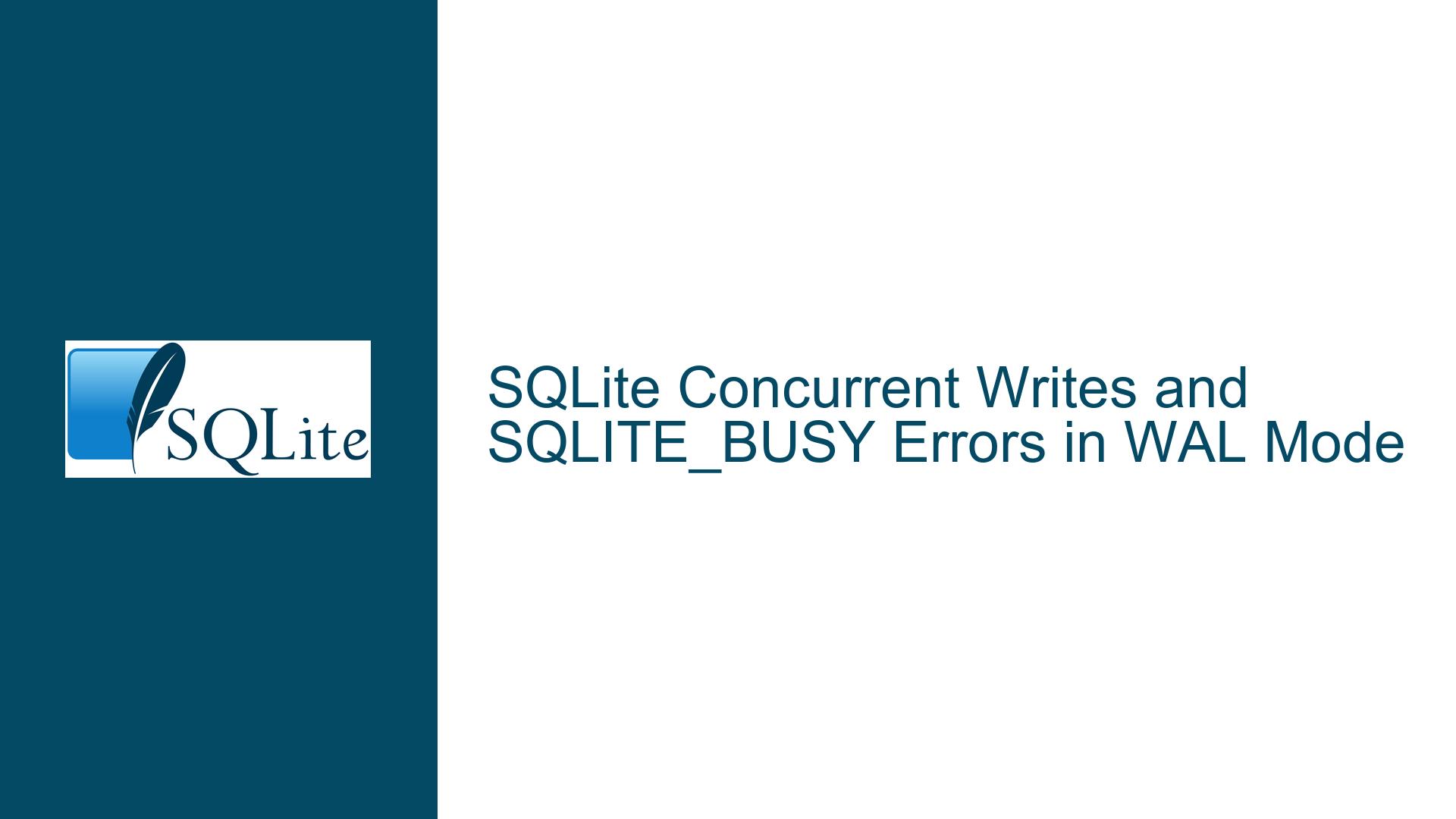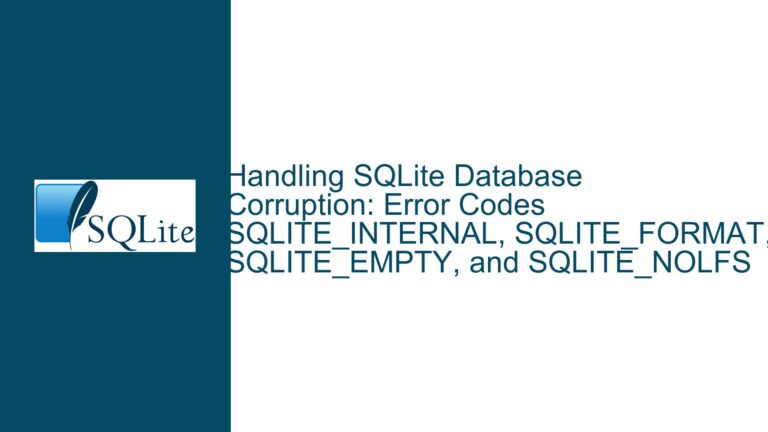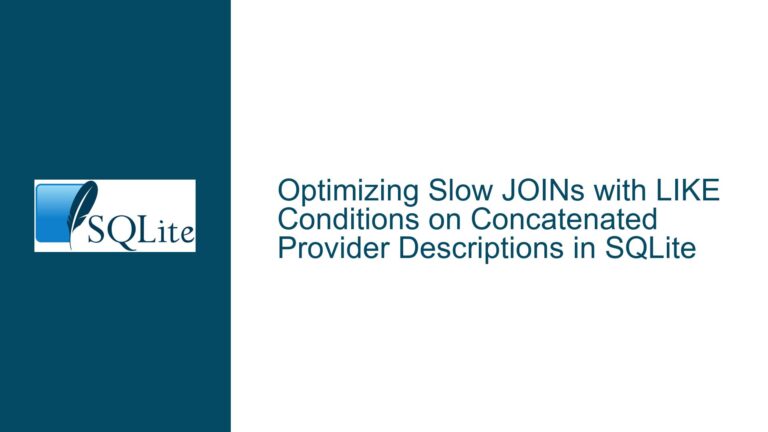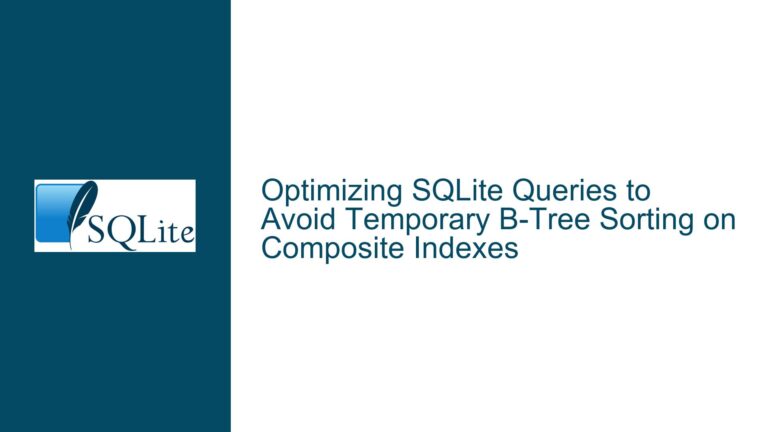SQLite Concurrent Writes and SQLITE_BUSY Errors in WAL Mode
SQLITE_BUSY Errors During Concurrent Writes in WAL Mode
When working with SQLite in Write-Ahead Logging (WAL) mode, particularly with the BEGIN CONCURRENT feature, users may encounter immediate SQLITE_BUSY errors during concurrent write operations. This issue arises even when the busy_timeout parameter is set, which is designed to make SQLite wait and retry before returning a SQLITE_BUSY error. The problem is particularly perplexing because the busy_timeout mechanism works as expected in standard rollback mode but fails to function correctly in WAL mode during concurrent transactions.
The SQLITE_BUSY error indicates that the database is locked and cannot proceed with the requested operation. In WAL mode, this error can occur due to contention between transactions, especially when multiple transactions attempt to modify the same pages in the database. The BEGIN CONCURRENT feature, which allows multiple transactions to proceed concurrently, can exacerbate this issue because it increases the likelihood of page conflicts. When such conflicts occur, SQLite may immediately return a SQLITE_BUSY error without respecting the busy_timeout parameter, leading to unexpected behavior in applications that rely on concurrent writes.
Understanding the root cause of this issue requires a deep dive into how SQLite handles concurrency in WAL mode, the role of the busy_timeout parameter, and the specific conditions under which SQLITE_BUSY errors are returned. Additionally, the use of the sqlite3_extended_errcode() function can provide more detailed information about the nature of the error, which is crucial for diagnosing and resolving the issue.
Interrupted Write Operations and Page Conflicts in WAL Mode
The immediate SQLITE_BUSY errors during concurrent writes in WAL mode can be attributed to several underlying causes, primarily related to how SQLite manages write operations and resolves conflicts between transactions. One of the key factors is the nature of WAL mode itself, which allows multiple readers and a single writer to operate concurrently. However, when multiple transactions attempt to write to the same pages, conflicts can arise, leading to SQLITE_BUSY errors.
In WAL mode, SQLite uses a versioning system to manage concurrent access to the database. Each transaction operates on a snapshot of the database, and when a transaction attempts to commit, SQLite checks for conflicts with other transactions. If a conflict is detected, SQLite may return a SQLITE_BUSY error. The busy_timeout parameter is designed to handle cases where the database is temporarily locked, such as when another transaction holds a write lock. However, in the case of page conflicts, SQLite may determine that retrying the operation is unlikely to succeed, leading to an immediate SQLITE_BUSY error.
Another factor contributing to this issue is the behavior of the BEGIN CONCURRENT feature. While BEGIN CONCURRENT allows multiple transactions to proceed concurrently, it does not change the fundamental conflict resolution mechanism in SQLite. As a result, when multiple transactions attempt to modify the same pages, the likelihood of conflicts increases, and SQLite may return SQLITE_BUSY errors more frequently. This behavior is particularly problematic in high-concurrency environments where multiple transactions are competing for access to the same resources.
The use of the sqlite3_extended_errcode() function can provide additional insights into the nature of the SQLITE_BUSY error. This function returns an extended error code that can help distinguish between different types of SQLITE_BUSY errors, such as those caused by write locks versus those caused by page conflicts. Understanding the specific cause of the error is crucial for determining the appropriate course of action.
Implementing PRAGMA journal_mode and Database Backup Strategies
To address the issue of immediate SQLITE_BUSY errors during concurrent writes in WAL mode, several strategies can be employed. These strategies involve adjusting the database configuration, optimizing transaction handling, and implementing robust backup and recovery mechanisms. One of the first steps is to ensure that the database is properly configured for concurrent access. This includes setting the appropriate PRAGMA journal_mode and PRAGMA synchronous settings to optimize performance and reliability.
In WAL mode, the PRAGMA journal_mode setting should be set to WAL or WAL2, depending on the specific requirements of the application. The WAL2 mode, introduced in SQLite 3.32.0, provides additional concurrency improvements by allowing multiple writers to operate concurrently under certain conditions. However, it is important to note that WAL2 mode may not completely eliminate SQLITE_BUSY errors, especially in high-concurrency environments.
The PRAGMA synchronous setting controls how SQLite handles write operations and ensures data integrity. In WAL mode, setting PRAGMA synchronous to NORMAL can improve performance by reducing the frequency of sync operations. However, this setting also increases the risk of data loss in the event of a power failure or system crash. For applications that require higher data integrity, setting PRAGMA synchronous to FULL is recommended, although this may result in reduced performance.
Another important consideration is the use of the busy_timeout parameter. While the busy_timeout parameter may not always prevent SQLITE_BUSY errors in WAL mode, it can still be useful in certain scenarios. For example, setting a reasonable busy_timeout value can help reduce the frequency of SQLITE_BUSY errors caused by temporary locks. However, it is important to recognize that the busy_timeout parameter is not a panacea and may not be effective in cases of page conflicts.
In addition to adjusting the database configuration, optimizing transaction handling can help mitigate SQLITE_BUSY errors. This includes minimizing the duration of transactions, reducing the number of concurrent write operations, and using appropriate locking mechanisms. For example, using BEGIN IMMEDIATE or BEGIN EXCLUSIVE can help reduce contention by acquiring the necessary locks at the start of the transaction, rather than waiting until the commit phase.
Finally, implementing robust backup and recovery mechanisms is essential for ensuring data integrity and minimizing the impact of SQLITE_BUSY errors. This includes regularly backing up the database, using checkpointing to reduce the size of the WAL file, and monitoring the database for signs of corruption. In the event of a SQLITE_BUSY error, having a well-defined recovery process can help ensure that the application can continue to operate without significant disruption.
In conclusion, addressing the issue of immediate SQLITE_BUSY errors during concurrent writes in WAL mode requires a comprehensive approach that includes adjusting the database configuration, optimizing transaction handling, and implementing robust backup and recovery mechanisms. By understanding the underlying causes of the issue and taking proactive steps to mitigate them, developers can ensure that their applications can handle concurrent writes effectively and maintain data integrity in high-concurrency environments.






